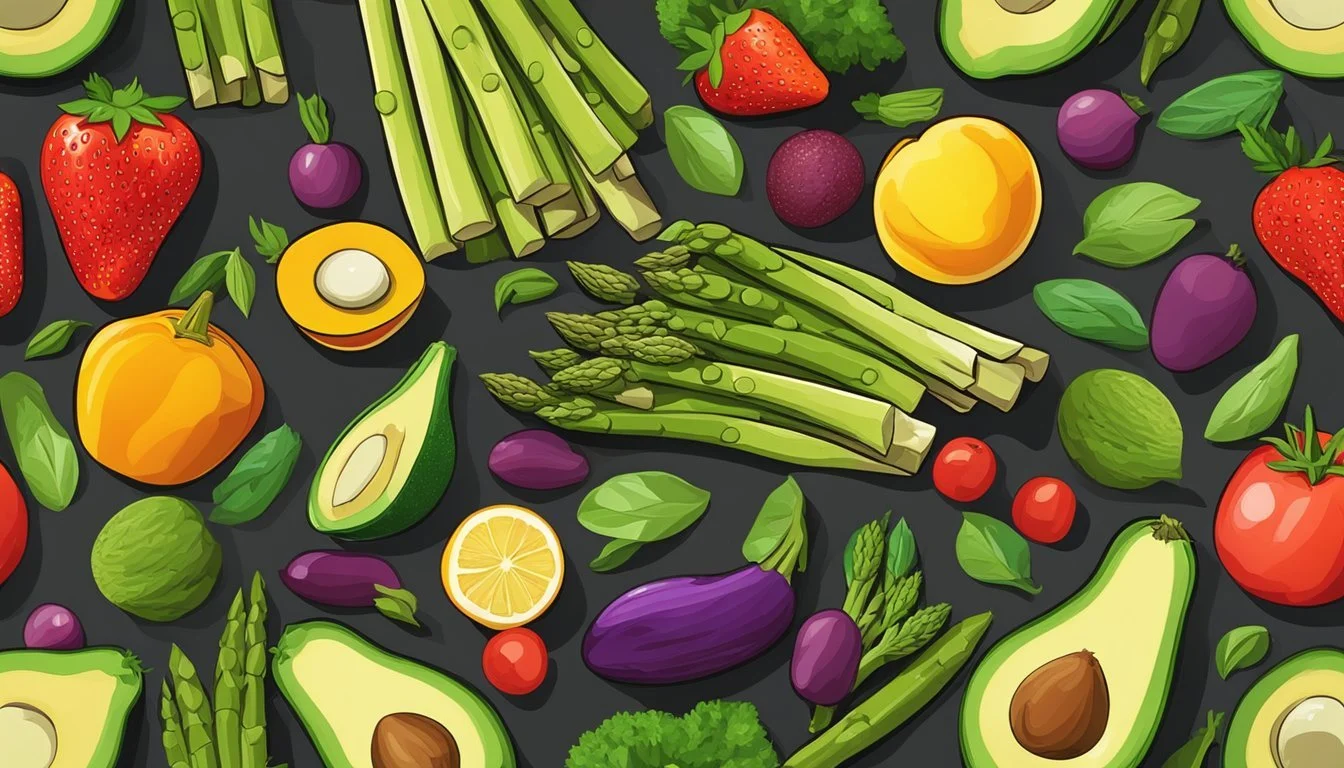California Seasonal Fruit & Vegetables in May
What to Look For
This Article is Part of our California Seasonal Fruit & Veg Calendar
California shines in May with an abundance of fresh produce, setting the stage for a season of vibrant fruit (What wine goes well with fruit?) and vegetable selection. As the spring warmth nudges the growth, farmers across the state begin to harvest a variety of fruits that are not just limited to the region, but are eagerly awaited by consumers and chefs alike for their peak flavors and nutritional value.
Seasonal fruits bursting to life in May include their renowned strawberries, which reach optimal sweetness and are a highlight in farmers' markets and stores throughout the state. Cherries (how long do cherries last?), another popular choice, add a pop of color and tartness to the seasonal palette. These fruits, along with apricots and their hybrid cousins the apriums, are central to California's springtime harvest, embodying the essence of the season with their rich, sun-ripened tastes.
Alongside these sweet offerings, a wide array of vegetables also come into season. Leafy greens, such as spinach (What wine goes well with spinach?), have just finished their cycle but are still available, while the fields make room for the impending varieties of summer produce. The diversity of California's climate zones allows for a unique agricultural breadth, ensuring that the selection of fruit and vegetables in May is both abundant and of exceptional quality.
Understanding California's Growing Seasons
California's diverse climate zones allow for a broad variety of fruits and vegetables to thrive. Depending on the season, the Golden State offers an abundance of fresh produce.
Spring in California
Spring is a dynamic period in California agriculture, stretching typically from March to June. During this time, the state experiences a noticeable transition from the cool, wetter winter months, leading to the warming temperatures that favor the growth of a multitude of crops.
Key Spring Crops:
Apricots: Harvested mainly from May to July.
Citrus fruits like Tangelos: Reach their peak from November through February, but some varieties are still available in Spring.
Seasonal Shifts and Produce Availability
California's agricultural output is affected by the shift from the rainy season to the drier, warmer spring months. This transition is crucial for determining the availability of various crops.
Available in May (Spring to Early Summer):
Stone fruits such as apricots and cherries begin to hit the markets.
Berries start coming into season, with strawberries being a notable springtime favorite.
Seasonal Availability Chart:
Produce Mar Apr May Jun Apricots ✓ ✓ ✓ Strawberries ✓ ✓ ✓ Cherries ✓ ✓ Citrus ✓
Adapting to the seasonal shifts is essential for California farmers and affects what is accessible to consumers in markets.
Fruit Highlights in May
May ushers in a bountiful period for fruit enthusiasts in California, with an array of berries and stone fruits coming into peak season, along with a selection of exotic and tropical varieties that add a unique twist to the typical fruit basket.
Berry Varieties
In May, shoppers can find strawberries at their juiciest, as they are amongst the starring fruits of the season. Consumed fresh or used in desserts, they are a favorite for their rich flavor. Blueberries also make their seasonal debut, offering a burst of sweet and tangy notes perfect for baking or as a fresh snack.
Stone Fruits and Citrus
Cherries and apricots are key attractions in the stone fruit category and are typically ready for harvest starting in May. Cherries come in both sweet and tart varieties, while apricots boast a soft, velvety skin and a sweet, tangy flesh. In the citrus sector, lemons continue to flourish, and blood oranges, known for their deep red flesh and sweet berry-like flavor, are still available but nearing the end of their season.
Exotic and Tropical Fruits
For an exotic twist, passion fruit, with its aromatic seeds and tart flavor, is in season and ideal for adding a tropical flair to dishes. Guavas are ripe for the picking, providing a rich source of Vitamin C. The small but flavorful kumquats can be enjoyed whole, skin and all. Lastly, cherimoyas, with their creamy texture and blend of banana, pineapple, and papaya flavors, are a unique seasonal offering not to be overlooked.
Vegetable Highlights in May
In California, May brings a rich variety of vegetables reaching their peak. Here are some of the standout vegetables available during this month:
Leafy Greens and Cruciferous Vegetables
Spinach and kale thrive in May, with their lush green leaves indicating peak freshness and nutrient density. These leafy greens are excellent for salads and sautéed dishes. (What Wine Pairs Best with Sautéed Dishes) Additionally, Brussels sprouts (how long do brussels sprouts last?) , which belong to the cruciferous family, are winding down but still available. They offer a slightly sweet, nutty flavor that enriches many springtime meals.
Spinach: Vibrant and versatile for raw or cooked dishes.
Kale: Tougher than spinach but ideal for hearty salads and stews.
Brussels Sprouts: Best roasted or stir-fried for a caramelized effect.
Root Vegetables and Tubers
While root vegetables are often associated with colder months, certain varieties like radishes are superb in May. They present crispness and a peppery kick, perfect for refreshing salads. Beets, with their earthy sweetness, can be roasted or boiled. Potatoes, the ever-popular tuber, continue to be a staple with a range of types from new to russet.
Radishes: Crunchy and sharp, add both flavor and color.
Beets: Deep-hued and sweet, suited to both savory and sweet dishes.
Potatoes: A diversity of varieties can be baked, mashed, or fried.
Alliums and Nightshades
May marks a great month for artichokes (What wine goes well with artichokes?), with their unique flavor and texture that makes them a favorite for steaming and dipping. Asparagus (how long does asparagus last?) is also at its peak, ideal for quick cooking methods like grilling or blanching. Moving towards summer, tomatoes and peppers begin to appear, hinting at the warmer months ahead. These nightshades start to gain the bright flavors and aromas characteristic of summer vegetables.
Artichokes: Tender hearts with a distinctive taste for a range of dishes.
Asparagus: Succulent spears needing minimal cooking for maximum flavor.
Tomatoes & Peppers: Early varieties start showing up, paving the way for summer feasts.
Local Farmers Market Guide
In California, May marks a time when local farmers markets are abundant with a variety of fresh produce. These markets provide an excellent opportunity to purchase fruits and vegetables at the peak of their season directly from the source.
Finding the Right Market
When searching for a local farmers market in the state of California, it's important to consider the location and timing of each market. Many cities host their own markets with diverse offerings of fresh produce. One can start by visiting the California Farmers' Markets Association website or local city directories to find a market nearby.
Most farmers markets operate weekly and are located in community spaces such as city parks or town squares. They may vary in size and the types of produce offered depending on the area and the local harvest. Individuals are encouraged to check the market's schedule and seasonality charts available for the state of California to ensure a visit when a wide range of produce is available.
What to Look for at Farmers Markets
At the farmers market, shoppers will encounter freshly harvested fruits and vegetables that often surpass what is available in grocery stores in terms of flavor and nutritional value. When visiting a farmers market in May, individuals should look for:
Seasonal Fruits: Cherries, strawberries, and apricots.
Seasonal Vegetables: Artichokes, asparagus, and various lettuces.
Purchasing from these markets supports local farmers and the local economy, and reduces the environmental impact of long-distance food transport. One should look for signs of freshness such as bright color, firm texture, and an absence of bruises or blemishes. Engaging with farmers can also provide insights into how the produce is grown and suggestions for the best selections.
Seasonal Recipes and Cooking Tips
In California, May is a prime month for enjoying a variety of fresh produce. Chefs and home cooks alike find pleasure in crafting recipes that showcase the vibrant flavors of the season’s bounty.
Utilizing Seasonal Produce in Recipes
Strawberries and Cherries: These fruits are a highlight of May, offering sweet flavors that are perfect for desserts or salads. One can prepare a refreshing strawberry spinach salad or a simple cherry clafoutis that allows the natural sweetness of the fruit to shine.
Avocado: Rich and creamy, Californian avocados are ideal for making guacamole or as an addition to sandwiches and wraps.
Artichokes: They can be steamed and served with a garlic aioli or lemon butter for a classic preparation.
Cooking Tip: Always aim to minimize the cooking time of fresh vegetables to preserve their nutrients and natural flavors.
Preserving Techniques for Off-Season
Canning: Canning is a reliable method for preserving May’s seasonal fruits. Strawberry jam and cherry preserves can be made using boiling water canning techniques, ensuring these flavors can be enjoyed year-round.
Strawberries: They can be hulled and canned as jams or whole in a sweet syrup.
Cherries: Pit and can cherries in syrup or as compote.
Preservation Tip: Always ensure to use sterilized jars and follow safe canning practices to prevent the growth of bacteria.
Sustainable Practices and Environmental Impact
In May, California's fruit and vegetable offerings are not just abundant but are also deeply connected to sustainable practices and minimizing environmental impacts.
Supporting Local Agriculture
Local farmers markets are vibrant with seasonal produce such as cherries, strawberries, and apricots. Sustainability is rooted in the support of these markets, as they often source directly from nearby farms. By prioritizing seasonal selections, consumers directly contribute to the livelihood of California growers and the local economy. This alignment with the growing seasons reduces the need for energy-intensive greenhouse production, further cementing the environmental benefits.
Reducing Food Miles and Carbon Footprint
The concept of food miles is critical when discussing sustainability and the environment. Seasonal fruits and vegetables in California travel shorter distances to reach consumers, significantly reducing transportation emissions. When local produce is purchased from a local farmers market, it often translates to a lower carbon footprint compared to imported goods. For instance, a head of lettuce grown in California and sold locally might travel under 50 miles, while the same head of lettuce, if imported, could travel over 1,000 miles, increasing its associated emissions. Identifying and choosing eco-friendly options available locally in May not only helps in conserving energy but also reduces greenhouse gas emissions, making a positive impact on climate change mitigation.







